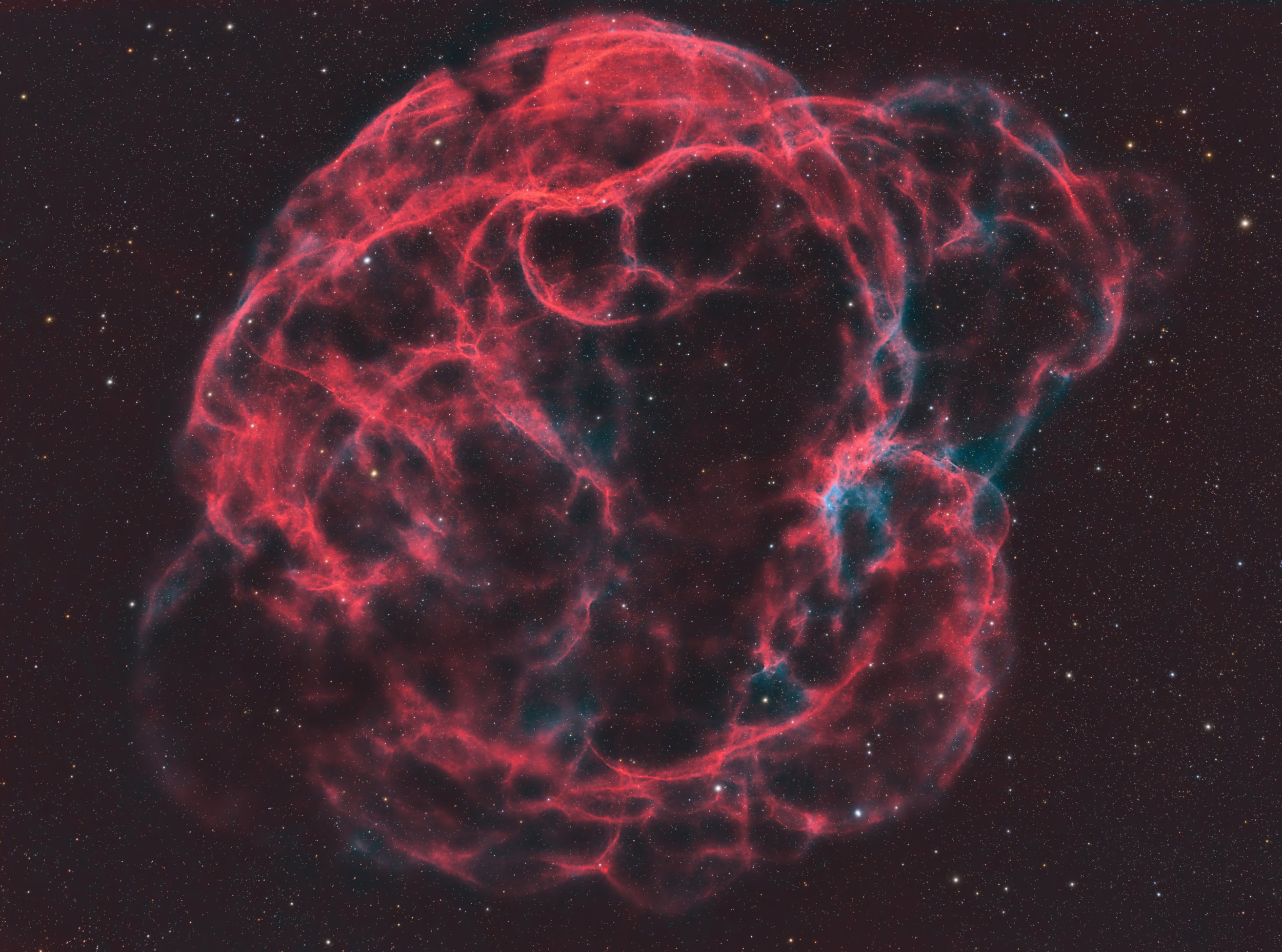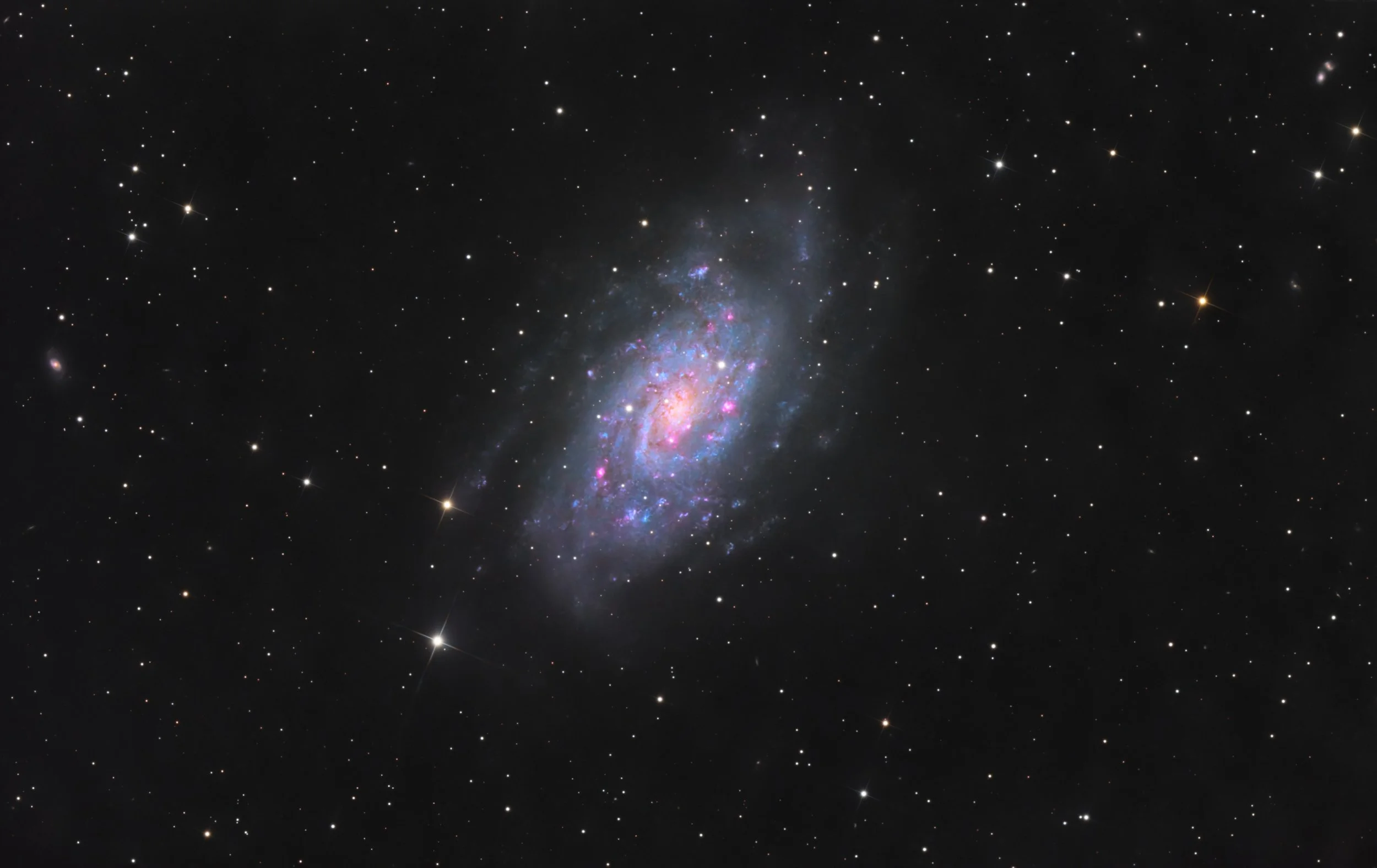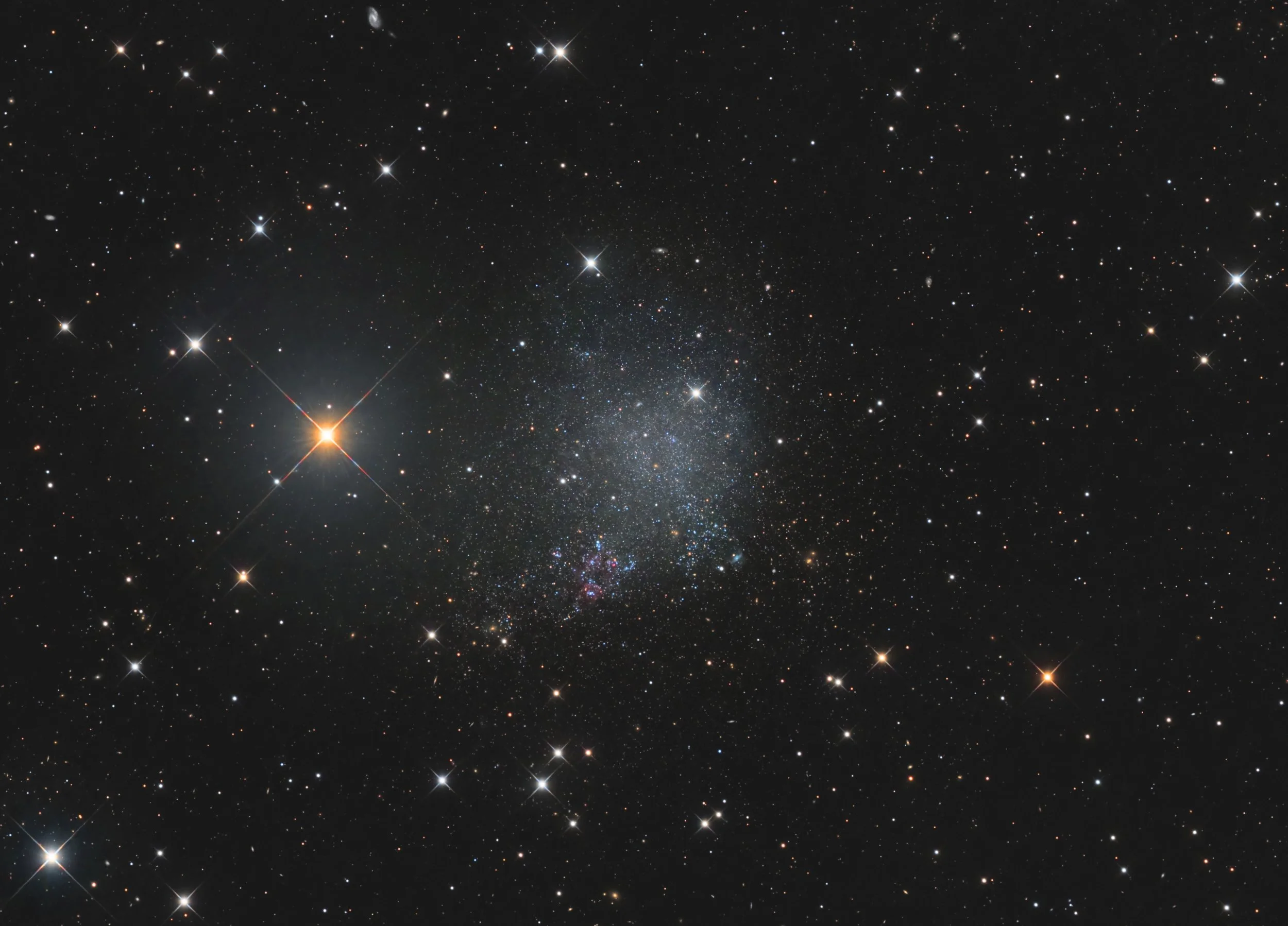
AAPOD2 Image Archives
Capella
Capella, the sixth brightest star in the northern hemisphere, takes center stage in this celestial display. The Akira Fuji Effect, a natural occurrence resulting from the star's inherent brilliance and the hazy crystals in the atmosphere, bathes Capella in a radiant aura that sets it apart from both background and foreground stars. This ethereal glow adds a touch of cosmic poetry to the star's luminous presence.
The rapid temperature drop plays a pivotal role in creating the haze of crystals, forming a delicate celestial tapestry that emphasizes Capella's brilliance. As one of the most prominent stars in Earth's night sky, Capella captivates observers with its celestial radiance and unique atmospheric halo, a celestial dance between starlight and the elements.
IC 2220 Toby Jug Nebula
C 2220's origin lies in the expelled cloud of gas and dust emanating from the red giant star HD 65750, nestled within the heart of the nebula. As the expelled material interacts with starlight, it creates a mesmerizing display of bi-conical structures that form the distinctive shape resembling an old English drinking vessel known as a Toby Jug.
Named by three discerning British astronomers, the Toby Jug Nebula stands out among its celestial counterparts for its unique hue. Unlike most reflection nebulae, IC 2220 dons a warm orange color, adding a touch of cosmic elegance to its whimsical appearance.
Spaghetti Nebula
Sh2-240, the Spaghetti Nebula, unfolds within the constellation Taurus, offering a celestial spectacle that defies earthly comparisons. This intricate emission nebula, illuminated by the energetic radiation of newborn stars, reveals delicate filaments resembling strands of celestial spaghetti, hence its evocative name.
In this cosmic kitchen, the Spaghetti Nebula serves as a testament to the dynamic interplay between stars and the interstellar medium. The tendrils of ionized gas and dust, intricately detailed in this image, showcase the ongoing cosmic processes that shape and mold the stellar nurseries within our Milky Way.
Southern Tadpoles
the enchanting Southern Tadpoles share the celestial stage with the stellar wonders NGC 3572 Gum37 and RCW54c. In this captivating ensemble, the Southern Tadpoles, officially cataloged as NGC 3786 and NGC 3788, elegantly intertwine with the celestial tapestry of star-forming regions, unveiling a harmonious display of cosmic beauty.
The larger of the tadpoles, NGC 3786, takes center stage with its graceful spiral structure reaching into the depths of space. Alongside it, NGC 3788, adorned with a distinctive tidal tail, weaves its own tale of gravitational interactions and cosmic evolution. Together, they form a celestial ballet that transcends the ordinary, inviting observers to witness the captivating interplay of galactic forces.
Adding to this cosmic symphony, NGC 3572 Gum37 and RCW54c emerge as stellar gems in the Hydra constellation. NGC 3572 Gum37, a dazzling star-forming region, illuminates the cosmic canvas with the brilliance of newborn stars, while RCW54c adds its ethereal glow to the celestial spectacle.
Situated approximately 150 million light-years away, the Southern Tadpoles, NGC 3572 Gum37, and RCW54c create a harmonious tableau that inspires awe and contemplation. This celestial convergence not only showcases the dynamic beauty of interacting galaxies but also celebrates the cosmic processes that give rise to new stars, perpetuating the ongoing dance of creation in the vast cosmic landscape.
Markarian's Chain
Markarian's Chain, a prominent feature in the Virgo Cluster, is a gravitational ballet of galactic proportions. Comprising a series of interacting galaxies linked by the force of gravity, this cosmic necklace spans the Virgo Cluster's core, captivating astronomers and stargazers alike with its mesmerizing allure.
This RGB image captures the intricate details of the galaxies within Markarian's Chain, each one a celestial jewel with its unique shape and structure. The gravitational interactions between these galaxies have given rise to stunning tidal tails and bridges, a testament to the complex dynamics shaping their shared cosmic destiny.
Situated roughly 50 million light-years away, Markarian's Chain provides a remarkable glimpse into the rich galactic diversity present in the Virgo Cluster. As part of the larger Virgo Supercluster, this cosmic ensemble invites contemplation of the vast cosmic structures that govern the distribution of galaxies across the cosmos.
Omega Centauri Widefield
Omega Centauri, the jewel of the southern skies, commands attention with its brilliant display of millions of stars packed in a gravitational embrace. As the brightest and most massive globular cluster in our Milky Way, Omega Centauri unfolds its celestial grandeur against the backdrop of the galactic halo.
Intertwined with this stellar masterpiece are the Integrated Flux Nebulae, delicate filaments of interstellar dust and gas that subtly reflect the combined light of distant stars. These faint nebular structures, often challenging to observe, add a layer of complexity and depth to the cosmic tableau surrounding Omega Centauri.
Captured in this image is the dynamic dance of light and shadow, where the brilliance of Omega Centauri's stellar ensemble harmonizes with the soft luminosity of the Integrated Flux Nebulae. The interstellar filaments, gently illuminated by the collective glow of background stars, unveil a celestial ballet that speaks to the intricate connections between cosmic elements.
M1 - A supernova remnant
The iconic Crab Nebula, also known as M1, a celestial masterpiece captured in the vast expanse of the Taurus constellation. This intricate nebula, born from a spectacular supernova explosion witnessed by astronomers in the year 1054 AD, stands as a testament to the dynamic forces shaping our cosmic neighborhood.
M1, the first entry in Charles Messier's catalog of astronomical objects, emanates from the remnants of a massive star that met its explosive fate. Located approximately 6,500 light-years away, the Crab Nebula spans about 11 light-years in diameter, showcasing the aftermath of the stellar explosion.
In the heart of the Crab Nebula resides a pulsar—a rapidly rotating neutron star that emits beams of radiation akin to a celestial lighthouse. This pulsar, a mere 20 kilometers in diameter, powers the nebula's glow and serves as a cosmic time capsule, preserving the memory of the cataclysmic event that gave birth to this celestial wonder.
Captured through the lens of astronomical observation, this image of the Crab Nebula unravels the intricate filaments of ionized gas and energized particles, offering a glimpse into the cosmic forces at play. The Crab Nebula's ongoing expansion and evolution make it a captivating subject for astronomers studying the life cycles of stars and the dynamic nature of our universe.
As we explore the luminous tendrils of the Crab Nebula, we are reminded of the perpetual dance between destruction and creation in the cosmos, inviting us to contemplate the beauty that arises from the remnants of stellar demise.
NGC 2403
NGC 2403, situated in the constellation Camelopardalis, is a spectacular spiral galaxy located approximately 8 million light-years away from Earth. This cosmic beauty spans about 50,000 light-years in diameter, making it roughly half the size of our Milky Way galaxy. NGC 2403 belongs to the M81 group, a small galaxy cluster that includes notable members such as Messier 81 and Messier 82.
This galaxy is renowned for its vibrant star-forming regions and features a considerable number of young, massive stars. NGC 2403 has been the subject of extensive astronomical observations and studies, providing valuable insights into the processes of star formation and galactic evolution. Its relatively close proximity to us makes NGC 2403 an ideal candidate for detailed astronomical investigations, contributing to our understanding of the broader cosmic landscape. As a member of the Local Group—a collection of galaxies that includes our own Milky Way—NGC 2403 adds to the rich tapestry of celestial wonders within our cosmic neighborhood.
Winter Orion
The Orion Complex encompasses a wealth of celestial phenomena, including the renowned Orion Nebula (Messier 42) at the heart of the Orion Molecular Cloud Complex. This captivating region, a stellar nursery teeming with newborn stars, emanates a vibrant glow that illuminates the surrounding cosmic landscape.
Nestled within the complex is the intricate Horsehead Nebula, a dark nebula silhouette against the brilliance of the emission nebula IC 434. The ethereal Flame Nebula, another jewel in Orion's crown, dances with the radiant light of nearby stars, creating a spectacle that mirrors the cosmic forces at play.
As we navigate through the Orion Complex, we encounter the intricate filaments of the Barnard's Loop, a vast and faint emission nebula that weaves its way through the cosmic expanse. The luminous stars of Orion's Belt, including the prominent Mintaka, Alnitak, and Alnilam, punctuate the celestial canvas, adding their brilliance to the cosmic narrative.
This composite image, a testament to the wealth of celestial wonders within the Orion Complex, beckons stargazers and astronomers alike to explore the rich diversity of our galactic neighborhood. Each nebula, star, and filament contributes to the celestial symphony that unfolds within the cosmic embrace of Orion, inspiring awe and contemplation of the majestic forces shaping our stellar surroundings.
IC1613 - One of our neighbors
IC 1613, a member of the Local Group of galaxies, stands as a testament to the quiet resilience of celestial bodies that persist on the cosmic stage. Despite its diminutive size compared to its spiral and elliptical counterparts, IC 1613 emanates a serene glow that speaks of its independent journey through the cosmic wilderness.
Captured in this image is the gentle luminosity of IC 1613, a galaxy characterized by a sparseness of stars and a lack of prominent spiral arms. Its unassuming presence invites contemplation of the cosmic forces that shape galaxies, as it navigates the vast cosmic sea in relative seclusion.
Comet 12P/Pons-Brooks
Comet 12/P, a periodic comet with an orbital period of about 70 years, has ventured from the outer reaches of our solar system to become a transient beacon in the night sky. This image captures its brilliant nucleus, enveloped in a delicate coma of gas and dust, as it reflects the Sun's light and paints a celestial brushstroke against the cosmic backdrop.
As the comet's trajectory brings it closer to Earth, it becomes a captivating sight for astronomers and sky gazers alike. The image showcases the dynamic nature of this celestial traveler, illustrating its evolution over time and highlighting the intricate details of its glowing tail, a testament to the solar wind's influence on its luminous display.
One- Month Sun Spots
As we examine at this month-long solar symphony, we gain a deeper appreciation for the Sun's role as the cosmic orchestrator, shaping the energy and life within our solar system. This image stands as a visual ode to the celestial dance that unfolds on the surface of our star, offering a glimpse into the captivating and ever-changing nature of the Sun's radiant presence.
Unveiling the Horsehead Nebula in IC 434
Delve into the cosmic canvas and witness the ethereal beauty of IC 434, where a celestial veil unveils the iconic Horsehead Nebula. This intricate region, nestled within the vastness of space, captivates observers with its enigmatic silhouette against the stellar backdrop.
IC 434, a designated dark nebula, hosts the Horsehead Nebula, a cosmic icon resembling the silhouette of a horse's head against the glow of the nearby emission nebula IC 434 itself. This striking interplay of light and shadow unfolds in the constellation Orion, a testament to the mesmerizing beauty that celestial phenomena can carve in the cosmic tapestry.
The Horsehead Nebula, a dense concentration of interstellar dust, obscures the brilliant glow of the background emission nebula, creating a celestial chiaroscuro. Illuminated by the nearby star Sigma Orionis, the delicate features of the Horsehead Nebula come to life, embodying the intricate dance between stellar radiation and the cosmic remnants scattered throughout the region.
Sh2-174
Situated against the vast cosmic tapestry, Sh2-174 reveals itself as a region of ionized gas, its luminous glow painting a portrait of stellar activity within its nebulous embrace. Though the exact distance remains a cosmic secret, this celestial spectacle offers a glimpse into the intricate dance between interstellar elements and the stellar forces that shape the universe.
The ethereal hues of Sh2-174, likely fueled by the presence of ionized hydrogen, present a captivating display of cosmic alchemy. As astronomers peer into its radiant depths, they embark on a journey to unravel the mysteries concealed within this celestial ember, probing the secrets of starbirth and interstellar dynamics.
LDN 1551
Situated against the cosmic backdrop, Sharpless 239 emerges as a region of ionized gas and dust, delicately illuminated by the embrace of newborn stars. The celestial watercolor, adorned with wisps of hydrogen alpha and other cosmic pigments, weaves a tapestry that captivates the imagination.
While its exact distance remains a celestial mystery, Sharpless 239's radiant glow speaks of a tranquil ballet between interstellar gases and the stellar forge. As we contemplate the enchanting dance of light and matter, Sharpless 239 invites us to reflect on the cosmic poetry that unfolds within the quiet corners of our vast and wondrous universe.
The heart of M42
Astronomers estimate the Orion Nebula's mass to be a staggering 2,000 times that of the Sun, attesting to the dynamic forces at play within this celestial crucible. As we peer into its radiant depths, we are granted a glimpse into the majestic theater of stellar genesis, where the cosmos weaves a tapestry of light and matter, perpetuating the cosmic dance of creation and destruction.
In the grand celestial symphony, the Orion Nebula stands as a beacon of brilliance, inviting us to marvel at the wonders of the universe and contemplate our place in the vastness of space.
Vela Supernova Remnant
Vela Supernova Remnant, an astronomical masterpiece born from the cataclysmic explosion of a Type II Supernova 11,000 years ago. This expansive mosaic, a testament to the enduring spirit of cosmic exploration, unravels across the constellation Vela, showcasing the remnants of a stellar explosion primarily composed of hydrogen alpha and oxygen III.
A monumental project spanning two seasons and requiring the meticulous capture of 14 panels, this massive mosaic is the result of a laborious effort undertaken over 12 months. Nights filled with patience and frustration converged to shape this cosmic panorama, encompassing about 103 megapixels in total actual size. The mosaic captures the intricate details of the Vela Supernova Remnant, a testament to the powerful forces unleashed in the heart of the universe.
NGC 253 - an island of stars
This stunning image unveils the captivating beauty of the Sculptor Galaxy, NGC 253, captured against the pristine Namibian night sky.
NGC 253, also known as the Sculptor Galaxy, is a stellar showcase of star formation and cosmic activity, situated approximately 11.5 million light-years away from Earth.
Notable features within NGC 253 include its central stellar core, dynamic spiral arms, and regions of intense star birth, all set against the velvety backdrop of the Namibian night.




















